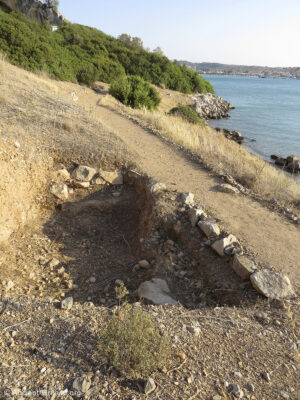A nearby sigh with information reads:
“The original Neolithic settlement expanded out of the cave and along the seashore, referred to as the ‘Paralia. This was occupied for the most part during the Neolithic (7,000 – 3,000 B.C.), in parallel with the cave itself. The settlement would have originally covered a few hectares and was located on the edge of a broad coastal plain. Towards the end of the Neolithic when sea levels had reached those of today, the plain was flooded and most of the Paralia submerged. The settlement consisted of an active and self-sufficient Neolithic community of farmers, herders and fishermen. Their houses had stone foundations, clay floors and plastered walls for insulation and hygiene. Their pots were made of clay, some intricately decorated, while sharp tools were made offlint and obsidian. Other types of tools including axes, chisels and millstones were made of hard rock such as serpentinite. Jewellery was made of simple natural objects such as marine shells. According to the excavators, a workshop designated for the production of marine shell jewelery was identified at Paralia.
Parts of the settlement were used for the burial of the dead, although it is not clear whether this took place during the height of occupation, or periods of abandonment. The settlement at franchthi was part of an extended network of Neolithic sites within the Argolid and beyond, in which people, ideas and objects circulated. The latter included obsidian from the island of Melos, hard rock for ground-stone tools from the Saronic Gulf, and clay for pots from Corinth and elsewhere.”
Franchthi Cave. Peloponnese, Greece.


